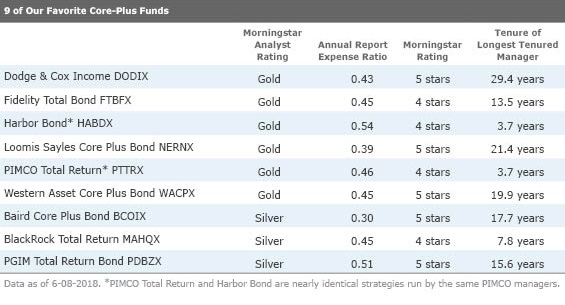9 of Our Favorite Core Plus Bond Funds
These daring intermediate-term bond funds have rewarded investors over time.
Bond funds are one of the predictably boring parts of many people's portfolio. And that's a good thing. As my colleague Christine Benz pointed out in a recent article examining asset class correlation data, high-quality bonds have been one of the most effective and reliable diversifiers for equity risk in a portfolio. That means that when your stock funds are losing money, your high-quality bond funds are likely holding up well.
But some investors prefer to be a little more daring with their bond allocation. Core plus fixed-income strategies invest in typical "safe haven" core bond fare, such as intermediate-term Treasury securities and high-quality corporates and mortgages. But core-plus strategies can take on a little more credit risk and/or interest-rate risk than more conservative peers. Core-plus strategies can also invest in more income-oriented or opportunistic fare such as nonagency MBS, lower-quality corporate bonds, or emerging-markets debt, which come with greater return potential but also court greater risk.
The list below contains nine core-plus funds that are rated highly by our manager research team. We take a closer look at three strategies.

This fund's process combines rigor and out-of-the-box thinking. Add in BlackRock’s deep human and tech resources and the fund's reasonable pricing, and it merits a Morningstar Analyst Rating of Silver.
The aforementioned rigor resides in the fund's risk management. Aladdin, BlackRock's risk and portfolio management system, is one of the industry's standards. This fund's custom-built risk dashboard, a part of Aladdin, decomposes the fund's risks in a variety of ways. Every system that relies on historical data is exposed to risk that the future won't be like the past. Nonetheless, this fund's system helps its managers monitor the distribution of risks, and they rely on it extensively. That's notable because the fund, whose benchmark is the Bloomberg Barclays U.S. Aggregate Bond Index, is a core-plus offering and takes on a variety of out-of-index bets, such as below-investment-grade paper, non-U.S.-dollar exposure, and emerging-markets debt.
The resulting performance has been quite strong. The fund stumbled a little in 2011, manager Rick Rieder's first full calendar year on the fund, when exposure to below-investment-grade paper and a shorter-than-benchmark duration pushed it to the bottom decile of its unique share-class peers. Its performance has been solid, though, ever since. --Maciej Kowara
Like a typical core-plus offering, this fund benchmarks itself against the Bloomberg Barclays U.S. Aggregate Index but can, and does, go out-of-index. High yield, bank loans, emerging markets, foreign developed, currencies, and nonagency mortgages have all at one point or another been part of the portfolio.
Top-down decisions are made by the firm's U.S. broad market strategy committee. Ken Leech, Western Asset's CIO, chairs the committee, which includes most senior investment and risk professionals. The committee determines duration, yield-curve positioning, and sector weightings. Once the committee has made its sector-allocation determination, sector teams step in to take care of bond selection. Guided by relative value considerations, they fill their sleeves with bonds that are attractive on their own and contribute toward achieving the fund's desired risk profile. The fund's performance has been excellent since the financial crisis of 2008,
Western Asset Core Plus Bond will be losing one of its longtime managers at the end of 2018, but that doesn't change our views on the fund's prospects. The fund retains its Morningstar Analyst Rating of Gold. --Maciej Kowara
Formerly Prudential Total Return Bond, this fund boasts a methodical approach, a strong risk framework, and impressive resources. Combined with reasonable pricing, those factors help support its Morningstar Analyst Rating of Silver.
This fund's managers focus on finding issues that have good fundamentals but generate a healthy amount of income. That gives it a bias toward corporates, securitized assets, and smaller helpings in non-U.S. developed- and emerging-markets debt, with very little exposure to Treasuries and agencies.
The team has long gravitated toward corporate credit. In that context, the managers compare internal credit scores against rating agencies', assign scores based on yield premiums versus the broad market, and build rankings based on liquidity and event risk. Internally developed risk analytics are then applied to portfolios.
Overall, the team has managed strong execution of a straightforward, well-developed strategy; its trailing long-term returns all place in its category's best quartile. --Eric Jacobson

/s3.amazonaws.com/arc-authors/morningstar/3a6abec7-a233-42a7-bcb0-b2efd54d751d.jpg)
/cloudfront-us-east-1.images.arcpublishing.com/morningstar/ZKOY2ZAHLJVJJMCLXHIVFME56M.jpg)
/cloudfront-us-east-1.images.arcpublishing.com/morningstar/IGTBIPRO7NEEVJCDNBPNUYEKEY.png)
/cloudfront-us-east-1.images.arcpublishing.com/morningstar/HDPMMDGUA5CUHI254MRUHYEFWU.png)
:quality(80)/s3.amazonaws.com/arc-authors/morningstar/3a6abec7-a233-42a7-bcb0-b2efd54d751d.jpg)